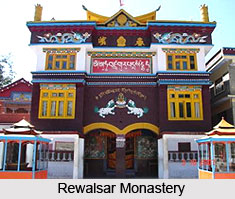 Rewalsar Monastery is one of the significantly hallowed monasteries, located 20km southwest of Mandi in Himachal Pradesh. It is a tranquil village with a small lake and surrounding woods, which is stunningly beautiful. Rewalsar is an important site of Buddhism in this state due to its legends about the 8th century saint, Padmasambhava. With water, woodlands and high hills, the site of Rewalsar presents an enchanting variety of natural beauty. The place, boasts of a refreshing beauty with its emerald green lake and thick woods in the surroundings. The interior of this gompa is ornamented with murals in Indo-Chinese approach. The locale, with its emerald green lake and the bordering woods, presents a pretty picture of nature`s grandeur. Moreover, the place is sacred for three religious communities of India - Hindu, Sikh and Buddhists.
Rewalsar Monastery is one of the significantly hallowed monasteries, located 20km southwest of Mandi in Himachal Pradesh. It is a tranquil village with a small lake and surrounding woods, which is stunningly beautiful. Rewalsar is an important site of Buddhism in this state due to its legends about the 8th century saint, Padmasambhava. With water, woodlands and high hills, the site of Rewalsar presents an enchanting variety of natural beauty. The place, boasts of a refreshing beauty with its emerald green lake and thick woods in the surroundings. The interior of this gompa is ornamented with murals in Indo-Chinese approach. The locale, with its emerald green lake and the bordering woods, presents a pretty picture of nature`s grandeur. Moreover, the place is sacred for three religious communities of India - Hindu, Sikh and Buddhists.
Foundation of Rewalsar Monastery
According to legend, Guru Padmasambhava built the Rewalsar Monastery in the 8th century. This pagoda style monastery stands on the shore of the famous Rewalsar Lake. Padmasambhava was a follower of Buddhism and belonged to the North West Frontier Province of Pakistan. He became a pioneer in spreading Buddhism in Himachal Pradesh. The locals knew him as Guru Rinpoche, the Buddhist preacher. The prime attraction of this monastery is the 150 ft statue of the Guru. The unique interiors of this monastery are a treasure trove of wall murals and stucco images.
Legends of Rewalsar Monastery
For Buddhist, the place is significant because of its association with Guru Padmasambhava. He was a sage from Pakistan skilled in tantric powers. Legends goes that he wished to train the daughter of the local king in meditation but the king was so infuriated that he had Padmasambhava thrown into flames. However, powerful as he was, Padmasambhava presented himself as a lotus flower surrounded by water. This impressed the king and allowed his daughter to be his disciple.
Another popular legend is of him making his way to Tibet on a tiger since the Emperor had invited him to ward off evil spirits from his kingdom. There, he overpowered the local deities and converted them into the protector of Buddhism. Thereafter, he established Tibet`s first monastery at Samye. Rewalsar is the place from where he departed for Tibet in order to spread Lamaism. Hence, the place attained a status of almost a pilgrimage destination. It is believed that in the caves around the lake, Padmasambhava left his footprints. He was responsible for establishing the famous Takshang Monastery in Bhutan.
The islands that float in the lake are believed to be inhabited by the spirit of Padmasambhava. It is famously said that the floating islands of reeds can be set into motion by both prayer and breeze.
Other attractions at Rewalsar Monastery
It is also home to some of the popular monasteries from the Nyingmapa order of Buddhism. The Drikung Kagyud Gompa, Tso-Pema Ogyen Heru-kai Nyingmapa Gompa and the Zigar Gompa are among the prominent monasteries of this order. A unique feature of these gompas is the amalgamation of the Indo-Chinese style of architecture. They have beautiful interiors adorned with stucco images and paintings.
Connectivity
Rewalsar is around 24 km from Mandi town by road. The Pathankot is the nearest railhead in Rewalsar. Bhuntar Airport is 57 km from Mandi district.



















